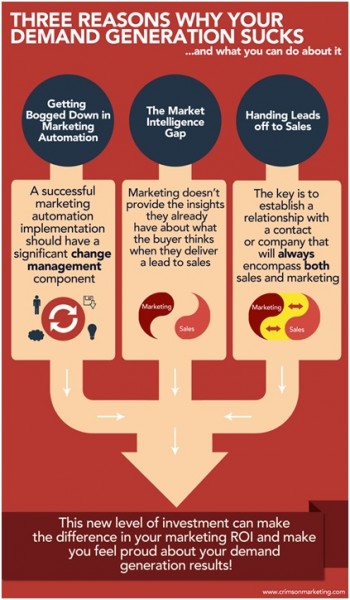Marketing departments are quite sophisticated in their demand generation efforts. The problem is the sales organizations don’t believe marketing is doing enough to create leads.
Why is that? What’s going on? If marketing is clearly getting better at demand gen, then why hasn’t its biggest customer—sales—congratulated them on their great work? Or thanked them for their contribution?
There are three main reasons why your demand generation stinks:
- Getting bogged down in marketing automation
- The market intelligence gap
- Handing leads off to sales
Let’s take more in-depth look at it each of these reasons.
Reason 1: Getting Bogged Down
Companies get bogged down in automation, because it’s not as “automatic” as we’d like it to be.
A successful marketing automation implementation has a significant “change management” component. That change management component gets the people, processes, and systems aligned, and it speeds up the changes needed for successful implementation.
In most cases, members of the marketing team are trained in the new software, and they usually have an understanding of what change management is needed. However, unless senior management drives the change management process, the change is very slow.
When the change management process is slow, the people who interact directly with the marketing automation system are only able to implement parts of that system. It’s a rare client that uses all the capabilities of their marketing automation system.
To improve the effectiveness of the marketing automation system and generate the right kind of leads, senior management must drive the change management process across the entire organization.
Reason 2: The Market Intelligence Gap
Marketing teams generally do a good job of understanding the early stages in the buyer’s journey. They closely monitor their competitors are
Marketing fails the sales department by not sharing these insights into what the buyer thinks. This is called the Market Intelligence Gap.
Marketing is so focused on delivering leads that they fail to deliver critical information that would help the sales rep succeed with those leads. Marketing invests time and resources collecting market, customer, and prospect information, but rarely do they provide those key insights when a member of the sales team begins to engage with that buyer.
To maximize the value sales gets out of a lead, marketing needs to help sales “meet the buyers where they are,” based on the market intelligence that’s been gathered about what the buyers are going through.
Marketing can close the Market Intelligence Gap by designing an information delivery system around what’s needed by the sales teams during their direct communication with the buyer.
Reason 3: Handing Leads off to Sales
No matter the effectiveness of your marketing campaign, or how qualified a lead appears to be when it’s handed off to sales, some percentage of those leads (typically a large percentage) are not ready for full ownership by the sales. This is why marketing should not “hand off” leads to the sales department.
Instead of a lead hand-off, marketing should introduce sales to a contact and/or company to establish a three-way relationship that encompasses both departments. This relationship will ebb and flow over time, and it will be influenced by factors that cannot be captured on any form.
Marketing isn’t handing over a lead; marketing is introducing the sales rep to a contact to increase the value of that relationship. However, marketing hasn’t abandoned the relationship; they’ve only added a sales rep to the relationship.
No matter how qualified a lead appears to be when it’s introduced to sales, a good sales rep goes through a deeper level of qualification that can’t be captured via a simple MQL, SAL, or SQL formula. The subtleties of the sales process are what the sales rep is paid to understand and uncover. That’s why a sales rep exists.
And, while the sales reps do their job, marketing works in the background to ensure that both the sales rep and the buyer receive the support they need from marketing. For example, the support might take the form of intelligence about a specific account for the sales rep, or new content that might help the buyer overcome some objections.
All the things we discussed require a different kind of thinking and level of investment by the marketing team, both during the marketing campaign and the sales process. But this different level of strategic marketing investment is what can make the difference in your marketing ROI and make you feel proud about your demand generation results.
